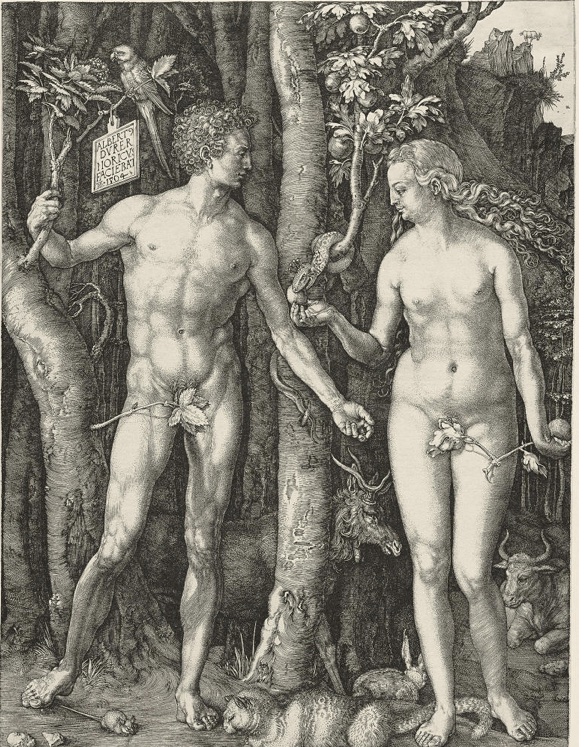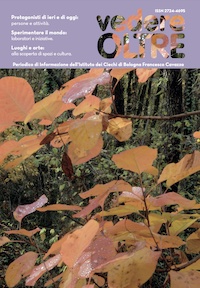Adam and Eve, or The Original Sin, is an engraving made by Albrecht Dürer in 1504. In conception it matured over a long time, in a period that straddles the two centuries when he was active in Germany and Italy. The artist, a native of Nuremberg, arrived at the recovery of the Vitruvian theory of proportions through the study of the Italian masters, inheriting an Apollonian vision of classicism that was never completely freed from a late Gothic influence.
Adam’s posture is reminiscent of the iconography of the God Aesculapius, but whereas the Apollo Medicus was attributed curative powers, due to the thaumaturgic faculties of the bow and arrow, the Apollonian-derived Adam is associated with the idea of the paradisiacal serenity that precedes disobedience to God, leading to the corruption of mankind. Adam is caught in the instant that anticipates the original sin, and of the heroic virile beauty of the God Apollo preserves the anatomy, no longer the proverbial impermanence. The first man betrays a tension that is almost an omen of destruction. Perhaps it is the state of unconscious curiosity that drives him to sin. Eve’s gaze does not explicitly betray the suspicion of error, but her right hand still grasps the wild rowan tree on which rests the reassuring parrot, which can be associated with the idea of the subject. The branch belongs to the tree of life and contrasts with the disturbing presence of the plant of evil, a sign of irrepressible knowledge, sacrilegious because it is an end in itself. On the latter is coiled the serpent, symbolizing temptation, and the invitation to go beyond the boundaries of the permissible. There is a dualism that affects the tension in the relationship between Adam and Eve and generates a contrast that returns in the mouse-feline, parrot-serpent pair. Thus emerges the negative significance of Eve, ideally assimilated to the serpent and the feline, identified with temptation, reproposed over the centuries as an emblem of disorder, transgression, abuse of free will, according to the dictates of a church influenced by the sinful symbols of femininity now stained by guilt.

The tree of discord divides Adam and Eve, marking a rift between the before and the after, that is, between the pristine paradisiacal life and the suffering existence resulting from original sin. As mentioned, the twig to which Adam holds himself, as if offering passive resistance to Eve’s invitation, represents the last weak foothold to salvation, before the unbalancing towards the deceptive plant, emblem of the forbidden, eloquent symbol of what cannot be violated but harming humanity, once discovered. In the background, balanced precariously on a cliff, appears a goat, possibly an ibex. In both cases, it would be a solitary sacrificial animal. According to the doctrine of temperaments, man, in his primeval state, lived in equilibrium and goodness as long as he was alienated from the predominant generated by one of the four humours: melancholic, phlegmatic, sanguine and choleric, mentioned in antiquity. These fluids, at first equivalent, underwent an alteration following the knowledge of sin and led to imbalances at the origin of evil, death and vice. Dürer’s adherence to this principle is confirmed not so much by his choice of biblical subject matter as by the presence of the creatures and the juxtapositions favoured by the German artist. A medieval theory, rehabilitated and widespread in the 16th century, states that certain animals embody the four humours that underlie the balance of beings. The hypothesis that Dürer had considered scholastic doctrine seems to be accredited by the presence of the moose, seen as an emblem of the melancholic temperament, the wild cat, thought of as an expression of choleric cruelty, the rabbit, always associated with lust, and finally the ox, approached with phlegmatic indolence. Dürer had to conceive the work as an expression of two models of classical beauty not detached from the moral value that beauty assumed in antiquity. Adam-Apollo echoes the classical hero warriors in his body and even in his hair. Eve-Venus, in facial appearance responds to Nordic-Renaissance physiognomies but in features refers to classicism. The choice of a canon of proportions coming from classical culture corresponds to the ideal of beauty and proportion expressed in the Greek kalokagathià, i.e., in the endiad kalos kai agathos translated as beautiful and good, the union of beauty and virtue. The Christianization of this principle gives rise to the medieval conception of pulchritudo, and the persistence of the latter in Renaissance thought is combined with revisions of classicism according to the well-known project of the Renaissance: rehabilitate classical culture, to trace its moral as well as formal models. Adam and Eve, beings about to lose their privileged serenity, act in a free will that is clouded by Luciferian persuasion. The dichotomy of the animal pairs around Adam and Eve represents the atavistic human desire: torn between individualistic satisfaction and acceptance of an insurmountable limit. The apparent harmony that dominates the scene is only a moment before the error and tragedy of expulsion, an irreversible condition for eternity. To the human being, the devotee of models and projects that violate the limits imposed by ethics and nature, it falls to the conflict of those who, caught up in the historical, political, and social contingency, choose with the foreboding of an evil foretold, defeated in the idea of a greater good. Even today, looking at this iconographic subject, one’s reflection goes to sin understood as arrogance, making Adam and Eve key figures of the ambivalence of knowledge; between hybris and anànche: sacrilege and destiny.





.png)